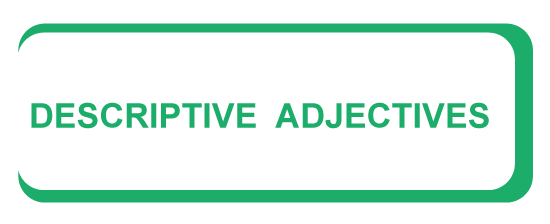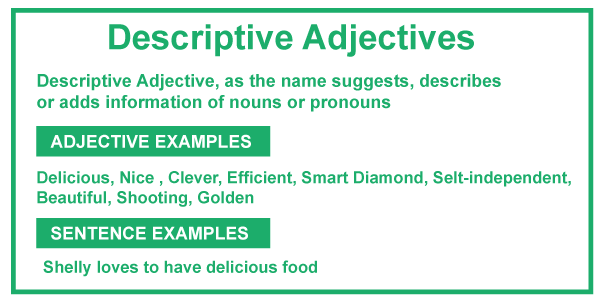Descriptive AdjectivesAdjectives in general can be used to express a wide range of emotions. Fortunately, with the help of adjectives, you can express someone that you had a fantastic celebration or that you ate a fantastic lunch. Adjectives can be used to describe an amazing vacation, a beloved movie, or even your pet dog. There are several different types of adjectives, although descriptive adjectives are the ones you require while describing anything. Adjectives exist in a variety of shapes and sizes, but they all share one feature: they are used to describe individuals, locations, and items. Descriptive Adjectives: What Are They?Descriptive adjectives are precisely what they seem like: descriptive words. Adjectives are terms to describe an individual, location, or object (if you're searching for terms that characterize verbs or other adjectives, look up adverbs). Descriptive adjectives are employed in sentences to clarify or add details. Colors, sizes, forms, and a variety of additional features are included. A descriptive adjective is one that alters a noun or pronoun by describing or conveying its characteristics. 
Consider the following sentences:
Thin and angry are descriptive adjectives in these lines. They equally describe the nouns they alter and provide information that we might use to characterize the objects they refer to. We know that the man would need to be less in weight and body mass to indicate to his thin body, and we also know that the chimpanzees are really angry that must have been observed from the individuals seeing them from a distance. "Don't all adjectives characterize the nouns and pronouns they alter?" you could ask. While the large bulk of adjectives are descriptive, certain adjectives do not truly describe the nouns or pronouns they change. These are referred to as limiting adjectives. A limiting adjective is used in the following sentence: Please give me that pencil. In this statement, the term "that" is an adjective which changes the noun pencil. The adjective indicates that the pencil is located relatively far away from the person speaking. However, the term " that" does not characterize the pencil's attributes or traits. We don't know what the pencil looks like, how big it is, how small it is, or anything else about it. The adjective "that" is not a descriptive adjective since it does not provide any details that can be used for describing the characteristics or characteristics of the noun it changes. 
Descriptive Adjectives ListSeveral of the adjectives you'll come across are descriptive adjectives. A descriptive adjective is defined as one that characterizes or qualifies the noun or pronoun that it changes. The below mentioned are some examples of descriptive adjectives: violent, blue, cautious, dry, enthusiastic, fast, fantastic, hot, unbelievable, jumpy, ditzy, little, powerful, nice, outrageous, prim, silent, rude, special, prickly, hidden, vicious, vast, youthful, lively Where Should a Descriptive Adjective Be Used in a Sentence?Descriptive adjectives are frequently employed prior to the nouns or pronouns they change or as the subject complement of a phrase after a connecting verb.
Steps to Follow in the Case of Descriptive Adjective Identification
Examples of Descriptive Adjectives in A StatementDescriptive adjectives are used in the sentences below. You'll note that each of these adjectives tells you something about a noun or pronoun's attributes or qualities. Example #1 I do not prefer hot weather. (The adjective cold modifies the term weather.) Hot is a descriptive term that characterizes the weather by stating that it is warm and hot.) Example #2 Her outfits are quite costly. (The adjective costly modifies the noun outfit.) Costly is a descriptive term that tells us the outfits are pricey.) Example #3 They used blue, yellow, and pink paint. (The noun paint is modified by the adjectives blue, yellow, and pink) These three adjectives are all descriptive adjectives that describe the paint's color. Best Practices for Descriptive Adjectives1. The most vital fact to notice about descriptive adjectives is that they appear after limiting adjectives in order of the adjectives and after non-descriptive terms such as articles and numerals. Since some is the limiting adjective, it comes before the descriptive adjective delicious. For example, we might say Daniel purchased some delicious grapes rather than Daniel purchased delicious some grapes. As another instance, we would say Maria owns a big house rather than Maria owns big a house. The descriptive adjective big comes before the article "a". 2. Several descriptive adjectives can be combined to generate comparative and superlative adjectives when comparing things. A mouse, for instance, is tiny, an insect is tinier, and a microbe is the tiniest of the three. A gold bracelet is also pricey, a house is more pricey, and a spaceship is the most pricey of all three. 4. A more difficult grammatical rule takes effect when you use many descriptive adjectives to alter the same noun or pronoun. When we utilize many adjectives, we usually adopt a certain adjective order. For instance, we are more inclined to say John has a little, inexpensive American car than John owns a cheap, American, small car. The Various Forms of Descriptive AdjectivesThe Descriptive Adjectives can be classified into three groups depending on the degree of comparison, as defined below in detail: 1. Comparative Descriptive AdjectiveAs the name implies, Comparative Adjectives are a form of an adjective utilized for describing a noun by comparing it to another noun. In other terms, a Descriptive adjective is used when one noun is compared to the other in a statement by an adjective. For instance, that orange is bigger than this orange. The word 'big' is employed in its comparative form as 'bigger' to describe the first orange as bigger than the latter. 2. Superlative Descriptive AdjectiveAs the name implies, these are adjectives that describe the highest degree of an attribute. Superlative Adjectives are adjectives that are used to characterize a noun by contrasting it to the other noun in the same sentence but with the greatest degree of comparison. In simpler terms, Superlative Adjectives express the comparison between two present nouns in a statement by their highest degree of similarity. For instance, that is the biggest orange on the tree. The term 'biggest' is employed here to prove that the specified orange is the largest among all the oranges in the same tree. 3. Positive Descriptive AdjectiveUnlike all other types of adjectives, Positive Adjectives are employed in the majority of sentences. These are not included in any form of comparison amongst nouns in a statement. Positive adjectives are used in English to describe a noun rather than to compare it to something else. As an example, her science grade is flawless. There is no comparison between nouns in this case. It is just pointing out the fact that kate scored perfectly in algebra. The term "perfect" refers to her mathematics score only. 4. Simple Descriptive AdjectivesSimple or common adjectives are equivalent as basic adjectives. In contrast to proper nouns, they are formed up of just one common word. These, like the other descriptive adjectives, can be joined with others to generate new combinations.
Here are some examples of Simple Adjectives
5. Compound Descriptive AdjectivesCompound adjectives are made up of multiple words and are utilized for describing a single noun or pronoun. In most circumstances, hyphens will be added;
Here are some compound adjective Sentences:
6. Proper Descriptive AdjectivesProper nouns give rise to proper adjectives. These specify the nation, area, religion, or era from which a term originates. Some of the examples of the same are;
Here are some proper descriptive adjective sentences;
The Proper Way to Use Descriptive AdjectivesTo employ any Descriptive adjective in a statement, you must first properly understand the nouns in the statement. If the nouns serve as a guideline for comparison between two objects, individuals, or circumstances, a Comparative Descriptive Adjective should be used. Example: This daffodil is prettier than that one. If the nouns are used to compare more than two objects, persons, or circumstances, and one of the nouns is the most important, you should employ a Superlative Descriptive Adjective. Example: Her hair is the longest in our school. If there is no foundation for comparison, a Positive Descriptive Adjective should be used. Example: That is great news. 
Important Points To Remember For Descriptive AdjectivesOne of the most prevalent sorts of adjectives are descriptive adjectives. They provide precise details, descriptions, or attributes about a noun, which improves understanding and adds depth to the sentence. Here are some key factors to remember about descriptive adjectives :
Example: "The lovely flower." (Adjective comes before noun ) "The flower is lovely." (Adjective following the linking verb "is." ) Let us have a look at the examples :
Altering Comparisons: Descriptive adjectives can also be employed for comparing or conveying degrees of comparison in comparative and superlative forms. Comparative: Taller and more attractive. Superlative: Tallest and most gorgeous. Multiple Descriptive Adjectives: To offer more precise and vivid descriptions, it is common to utilize multiple descriptive adjectives simultaneously. The following sequence generally determines the order of numerous adjectives: opinion, size, age, form, color, origin, material, purpose. Example: "A lovely old metal chest." Subject-Verb Agreement: Descriptive adjectives have to correspond in number and gender with the noun they alter. Example: "The pink apples." (plural noun ) "The tall building." (singular noun ) Descriptive adjectives are essential for effectively portraying people, places, things, and thoughts. You can generate more engaging and precise descriptions by carefully picking and positioning descriptive adjectives, making your writing or speech more fascinating and vibrant. Some More Examples of Descriptive AdjectivesThe descriptive adjectives have been highlighted in the sentences below;
Some of the Descriptive AdjectivesHere is the list of descriptive adjectives;
Note : Descriptive Adjectives can be simple, proper adjectives (containing proper nouns) or compounded (containing hyphens between the two words or more than one word).Descriptive adjectives are extremely useful and abundant in everyday English. They assist in making your phrases more explicit and your directions more precise.
Next TopicDistributive Adjectives
|
 For Videos Join Our Youtube Channel: Join Now
For Videos Join Our Youtube Channel: Join Now
Feedback
- Send your Feedback to [email protected]
Help Others, Please Share









